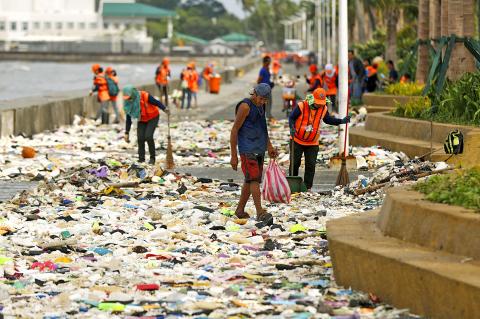At least four people were killed after Super Typhoon Haima smashed into the northern Philippines with ferocious wind and rain, flooding towns and forcing thousands to flee, although it slightly weakened yesterday after slamming into a mountain range on its way to the South China Sea, officials said.
Haima’s blinding wind and rain had rekindled fears and memories from the catastrophe wrought by Typhoon Haiyan in 2013, but there were no immediate reports of any major damage amid spotty communications and power outages in several provinces.
Thousands of villagers were moved to emergency shelters as the typhoon approached.

Photo: EPA
Two construction workers died when a landslide buried their shanty in La Trinidad town in the mountain province of Benguet, officials said, while two villagers drowned in floodwaters in Ifugao province, near Benguet.
The typhoon slammed into the shore in Cagayan province late on Wednesday and lashed the mountainous province of Apayao at dawn with slightly weaker sustained winds of 205kph and gusts of 285kph. It was blowing northwestward at 25kph toward the tobacco-growing Ilocos Norte, the last province before it exits toward the South China Sea, forecasters said.
In Narvacan town in northern Ilocos Sur province, ricefields resembled a brown lake under waist-high floodwaters. Despite the still-strong wind and rain, government workers have started clearing roads blocked with toppled trees and all kinds of debris.

Malaysia yesterday installed a motorcycle-riding billionaire sultan as its new king in lavish ceremonies for a post seen as a ballast in times of political crises. The coronation ceremony for Malaysia’s King Sultan Ibrahim, 65, at the National Palace in Kuala Lumpur followed his oath-taking in January as the country’s 17th monarch. Malaysia is a constitutional monarchy, with a unique arrangement that sees the throne change hands every five years between the rulers of nine Malaysian states headed by centuries-old Islamic royalty. While chiefly ceremonial, the position of king has in the past few years played an increasingly important role. Royal intervention was

X-37B COMPARISON: China’s spaceplane is most likely testing technology, much like US’ vehicle, said Victoria Samson, an official at the Secure World Foundation China’s shadowy, uncrewed reusable spacecraft, which launches atop a rocket booster and lands at a secretive military airfield, is most likely testing technology, but could also be used for manipulating or retrieving satellites, experts said. The spacecraft, on its third mission, was last month observed releasing an object, moving several kilometers away and then maneuvering back to within a few hundred meters of it. “It’s obvious that it has a military application, including, for example, closely inspecting objects of the enemy or disabling them, but it also has non-military applications,” said Marco Langbroek, a lecturer in optical space situational awareness at Delft

The Philippine Air Force must ramp up pilot training if it is to buy 20 or more multirole fighter jets as it modernizes and expands joint operations with its navy, a commander said yesterday. A day earlier US National Security Adviser Jake Sullivan said that the US “will do what is necessary” to see that the Philippines is able to resupply a ship on the Second Thomas Shoal (Renai Shoal, 仁愛暗沙) that Manila uses to reinforce its claims to the atoll. Sullivan said the US would prefer that the Philippines conducts the resupplies of the small crew on the warship Sierra Madre,

AIRLINES RECOVERING: Two-thirds of the flights canceled on Saturday due to the faulty CrowdStrike update that hit 8.5 million devices worldwide occurred in the US As the world continues to recover from massive business and travel disruptions caused by a faulty software update from cybersecurity firm CrowdStrike, malicious actors are trying to exploit the situation for their own gain. Government cybersecurity agencies across the globe and CrowdStrike CEO George Kurtz are warning businesses and individuals around the world about new phishing schemes that involve malicious actors posing as CrowdStrike employees or other tech specialists offering to assist those recovering from the outage. “We know that adversaries and bad actors will try to exploit events like this,” Kurtz said in a statement. “I encourage everyone to remain vigilant